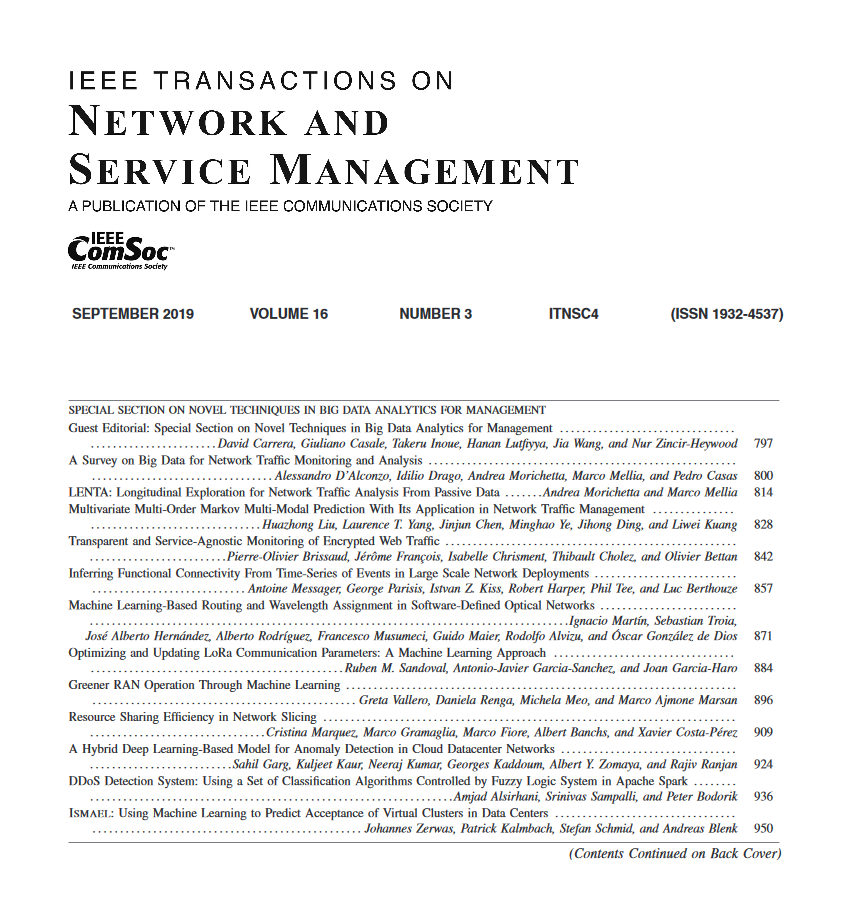DINT-Based DWRR: Decentralized INT-Based Packet Scheduling Method for Multipath Communication
IF 5.4
2区 计算机科学
Q1 COMPUTER SCIENCE, INFORMATION SYSTEMS
IEEE Transactions on Network and Service Management
Pub Date : 2025-07-25
DOI:10.1109/TNSM.2025.3592748
引用次数: 0
Abstract
Multipath communication is a technique that utilizes multipath transmission to improve network transmission efficiency. Multipath transport protocols like MPTCP usually require complex signaling control and lack adaptability to instantaneous network changes. The advent of programmable switches and INT has addressed these issues to some extent. In this paper, we propose DINT-Based DWRR (Decentralised INT-Based Dynamic Weight Round Robin), a dynamic weight round-robin packet scheduler based on non-centralized telemetry technology. It aims to collect telemetry information and update path weights with millisecond granularity, and efficiently achieve load balancing while reducing telemetry overhead. The core idea of DINT-Based DWRR is to leverage data-plane programmability to achieve the convergence of the forwarding node and the computing node. The forwarding nodes forward the packets using the DWRR (Dynamic Weight Round Robin) method and periodically generate telemetry messages. The computing nodes are dispersed across the forwarding nodes and efficiently update weights to the forwarding nodes. After testing in various experimental scenarios, it is proven that DINT-Based DWRR can provide better scheduling policies, reduce the link packet loss rate, and increase link bandwidth utilization.基于int的DWRR:多路径通信中基于int的分散分组调度方法
多径通信是一种利用多径传输来提高网络传输效率的技术。像MPTCP这样的多路径传输协议通常需要复杂的信令控制,并且缺乏对瞬时网络变化的适应性。可编程开关和INT的出现在一定程度上解决了这些问题。本文提出了一种基于非集中式遥测技术的动态权重轮询分组调度程序——基于int的DWRR (decentralized INT-Based Dynamic Weight Round Robin)。它旨在以毫秒粒度收集遥测信息并更新路径权值,在降低遥测开销的同时有效地实现负载均衡。基于dint的DWRR的核心思想是利用数据平面的可编程性来实现转发节点和计算节点的收敛。转发节点采用DWRR (Dynamic Weight Round Robin)方式转发报文,并定期生成遥测报文。计算节点分散在转发节点上,并有效地更新转发节点的权重。经过各种实验场景的测试,证明基于dint的DWRR可以提供更好的调度策略,降低链路丢包率,提高链路带宽利用率。
本文章由计算机程序翻译,如有差异,请以英文原文为准。
求助全文
约1分钟内获得全文
求助全文
来源期刊

IEEE Transactions on Network and Service Management
Computer Science-Computer Networks and Communications
CiteScore
9.30
自引率
15.10%
发文量
325
期刊介绍:
IEEE Transactions on Network and Service Management will publish (online only) peerreviewed archival quality papers that advance the state-of-the-art and practical applications of network and service management. Theoretical research contributions (presenting new concepts and techniques) and applied contributions (reporting on experiences and experiments with actual systems) will be encouraged. These transactions will focus on the key technical issues related to: Management Models, Architectures and Frameworks; Service Provisioning, Reliability and Quality Assurance; Management Functions; Enabling Technologies; Information and Communication Models; Policies; Applications and Case Studies; Emerging Technologies and Standards.
 求助内容:
求助内容: 应助结果提醒方式:
应助结果提醒方式:


